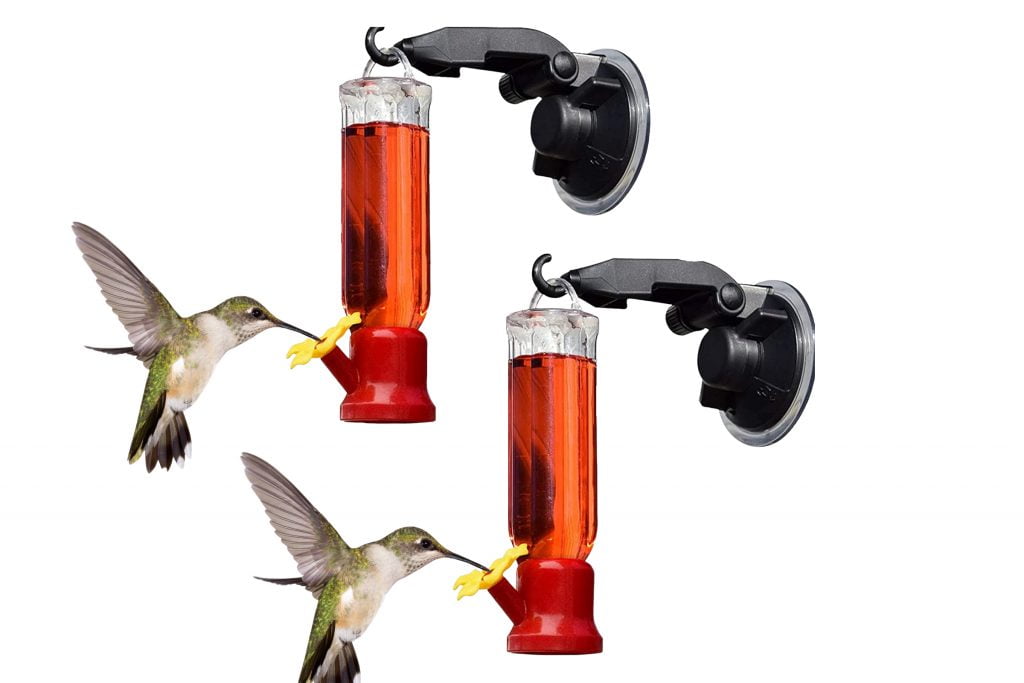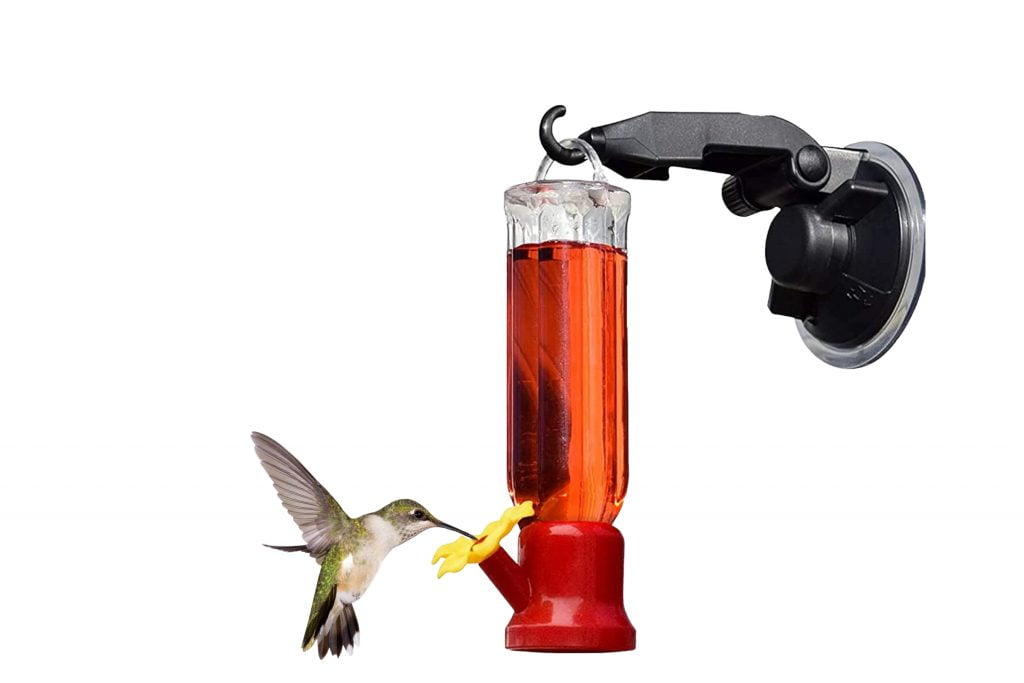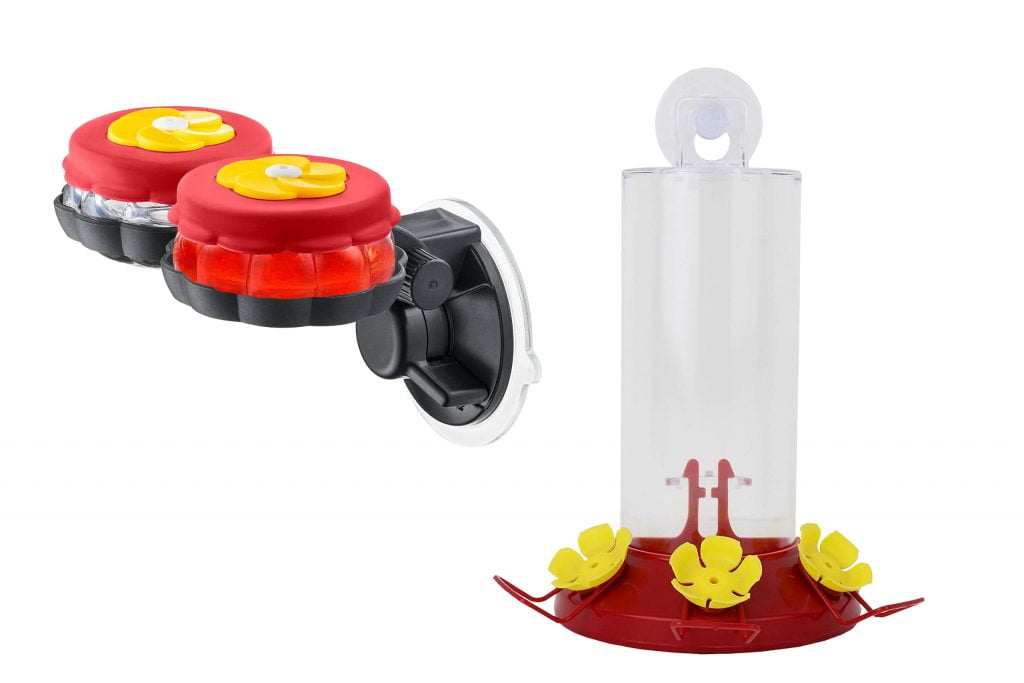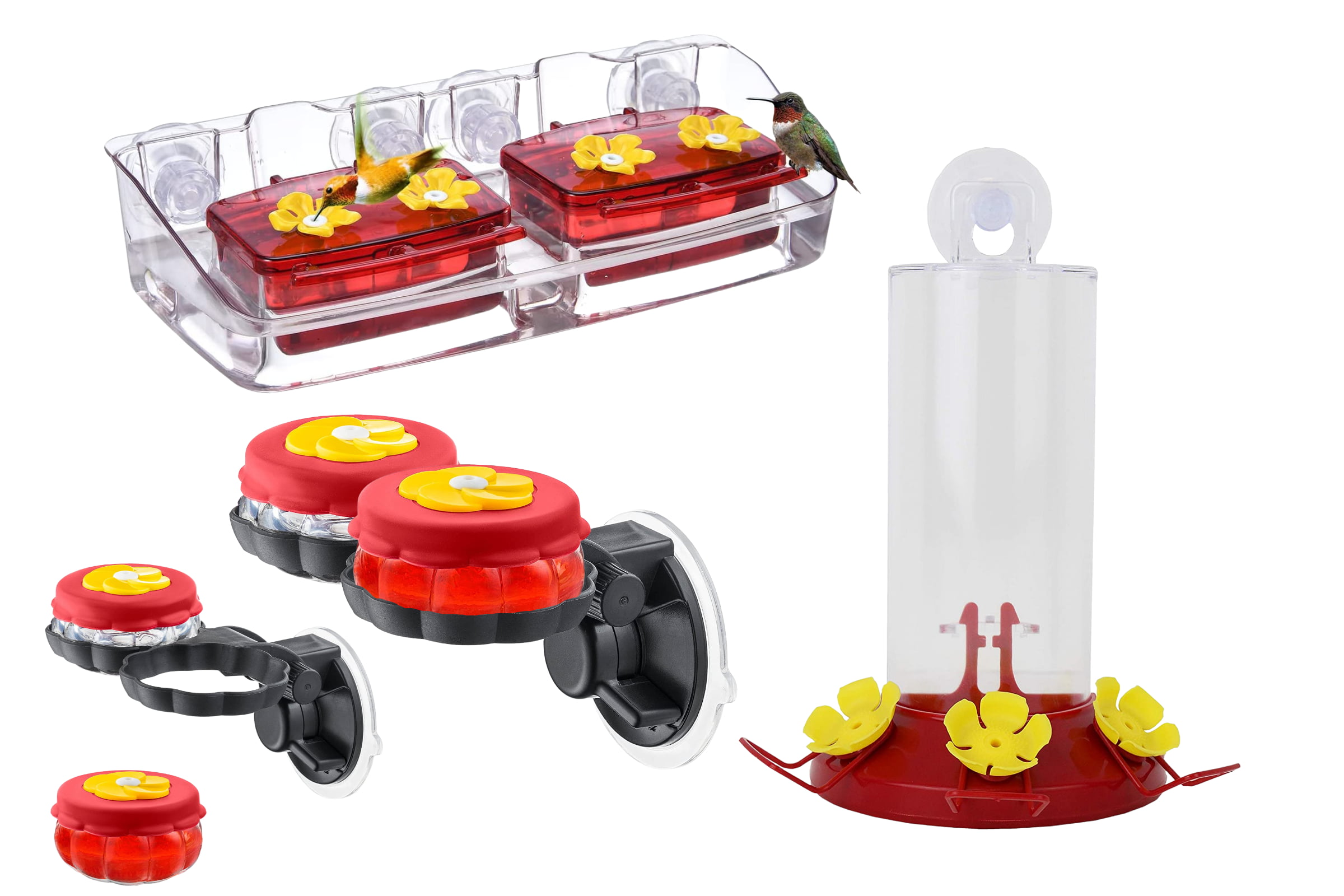One common question about window hummingbird feeders is whether they are safe for hummingbirds. The short answer is, Yes, window hummingbird feeders are safe for birds when used correctly. They provide a convenient, up-close view of these fascinating creatures while offering them a reliable source of nourishment.
However, it’s essential to follow best practices to ensure the feeders don’t inadvertently harm the birds. In this post, we’ll discuss all you need to know about window Hummingbird Feeders, their concerns, their benefits, the right ways to use them and helpful tips to consider.
- Understanding the Concerns
- The Benefits of Window Hummingbird Feeders
- The Right Way to Use a Window Hummingbird Feeder
- Tips for Using Window Hummingbird Feeders
- Final Thoughts
- FAQs – Are Window Hummingbird Feeders Safe for Birds?
- Q: What are the potential risks of using a window hummingbird feeder for birds?
- Q: Can window hummingbird feeders cause harm to hummingbirds or other birds that use them?
- Q: What are the best practices for maintaining a safe window hummingbird feeder for birds?
- Q: Are There Any Specific Types of Window Hummingbird Feeders That Are Safer for Birds to Use?
- Q: What Are the Common Hazards That Birds May Face When Using a Window Hummingbird Feeder?
- Q: How Can I Tell if My Window Hummingbird Feeder is Safe for Birds to Use?
- Q: Are Any Alternative Options to Window Hummingbird Feeders Safer for Birds?
- Q: How Can I Prevent Accidents or Injuries to Birds When Using a Window Hummingbird Feeder?
- Q: Do hummingbirds prefer window feeders or garden feeders?
- Q: How often should I clean my window hummingbird feeder?
- Q: What should I use to clean my window hummingbird feeder?
- Q: What can I do to make my window hummingbird feeder more attractive to birds?
- Q: Can I use honey or artificial sweeteners in my hummingbird feeder?
- Q: What can I do if predators are becoming a problem at my window hummingbird feeder?
- Q: What's the best way to introduce a new window hummingbird feeder?
- Q: How does a window hummingbird feeder contribute to hummingbird conservation?
- Q: Is red dye necessary in the nectar for window hummingbird feeders?
- Q: How high should I place my window hummingbird feeder?
- Q: Can I use a window hummingbird feeder to feed other types of birds?
- Q: How can window hummingbird feeders foster a love for nature?

Understanding the Concerns
It’s natural to worry about the safety of window hummingbird feeders and, indeed, any bird feeders. These concerns often revolve around three main issues: collisions with the window, hygiene of the feeder, and the risk of predation.
However, these concerns can be effectively managed or prevented with proper precautions and care.
The Risk of Collisions
Birds, including hummingbirds, may not recognise glass as a solid barrier, which can lead to collisions. Birds can be seriously injured or even killed in these incidents. However, hummingbirds are agile flyers and often avoid these accidents, and window feeders can even decrease the chance of window strikes.
The feeder serves as an obvious visual cue, helping hummingbirds identify the window as an obstacle. Moreover, when a feeder is attached directly to the window, the birds don’t gain enough flight speed to harm themselves significantly should they mistakenly fly into the glass.
To further reduce this risk, consider using window clings or decals that reflect ultraviolet light, which is visible to birds but almost invisible to humans. These markers alert the birds to the presence of the glass, helping to avoid any potential accidents.
Feeder Hygiene and Disease
Hummingbird feeders, whether window-mounted or not, can become sources of disease transmission if not cleaned properly. Bacteria and fungi thrive in the sugary solution often used in these feeders, potentially causing harm to the birds.
It’s crucial to clean window hummingbird feeders regularly, at least once every few days, and more often during hot weather.
A solution of one part white vinegar to four parts water is effective for cleaning. Rinse thoroughly after cleaning to ensure no residue remains. Regular cleaning not only protects the hummingbirds but also ensures a clear view of these delightful creatures.
Predation Risks
Window hummingbird feeders, like all bird feeders, can attract predators. Cats are a common threat, as are larger birds and small mammals. However, because window feeders are typically closer to human activity, they can actually be safer than feeders located further away. Predators are usually wary of human presence and may be deterred from approaching.
Nevertheless, it’s essential to monitor your feeder and its surroundings for potential threats. If you have cats, ensure they’re kept indoors, and if larger birds become a problem, consider a bird feeder specifically designed to discourage them.

The Benefits of Window Hummingbird Feeders
Despite potential concerns, window hummingbird feeders are a boon to hummingbird lovers and the hummingbirds. They come with a myriad of benefits that, with proper care and precautions, outweigh the potential risks.
- Educational Opportunities: Having a window hummingbird feeder provides a unique opportunity for close observation of these fascinating birds. Their rapid wing movement, feeding habits, and colourful plumage can be clearly seen. This can be a wonderful educational tool for children and adults alike, fostering an interest in ornithology and the natural world.
- Supports Hummingbird Survival: Window hummingbird feeders provide a reliable food source, particularly during periods of natural food scarcity. During times of migration or in the late summer before many flowers bloom, feeders can be a crucial supplement to help hummingbirds maintain their high energy needs.
- Promotes Wildlife Appreciation: By bringing hummingbirds closer to our living spaces, window feeders help to build a connection with these remarkable creatures. Observing them can foster a deeper appreciation for wildlife and the ecosystems they inhabit.
- Enhances Outdoor Spaces: A window hummingbird feeder can add life and colour to your outdoor space. The sight of hummingbirds flitting to and fro can bring joy and peace, enhancing your overall well-being.
- Contributes to Citizen Science: Observing hummingbirds at your feeder can contribute to citizen science projects that track bird populations and behaviours. Your observations can help scientists understand more about hummingbird migration patterns, lifespan, and behaviour.
- Encourages Conservation: Having a window hummingbird feeder can inspire a greater interest in conservation. It can act as a reminder of the beauty of the natural world and our responsibility to protect it.
- Fostering a Love for Nature: Window hummingbird feeders can serve as a catalyst to foster a love for nature, especially among children. They provide a unique opportunity to observe these birds up close, piquing curiosity and encouraging an interest in bird watching and conservation.
Each of these benefits underscores the value of window hummingbird feeders, not only as a source of enjoyment and learning but also as a way of supporting hummingbird populations and fostering a greater appreciation for nature.

The Right Way to Use a Window Hummingbird Feeder
To ensure the safety of the birds, follow these best practices:
- Clean the feeder regularly: As mentioned, hygiene is paramount. Regular cleaning prevents the growth of harmful bacteria and fungi. It’s also vital to change the nectar frequently, preferably every two to three days.
- Install anti-collision markers: If possible, install decals or window clings that reflect ultraviolet light. This can help prevent collisions by making the glass more visible to the birds.
- Monitor for predators: Keep an eye on your feeder and its surroundings. If you notice predators, consider moving the feeder or taking other steps to deter them.
- Use the right nectar: Avoid using honey or artificial sweeteners in your feeder, as these can be harmful to hummingbirds. Stick to a solution of one part white sugar to four parts water, which closely mimics the nectar hummingbirds would find in nature.
- Position the feeder correctly: Place the feeder at least four to five feet above the ground and away from any areas where predators may lurk. If possible, place it near flowering plants to provide a natural source of nectar and attract more birds.

Tips for Using Window Hummingbird Feeders
To make the most of your window hummingbird feeder experience while ensuring the safety and health of the hummingbirds, here are some additional tips:
- Provide a variety of food sources: While the sugar solution in your feeder is a great energy source for hummingbirds, it doesn’t provide all the nutrients they need. Planting native flowers that produce nectar is an excellent way to supplement their diet.
- Don’t use red dye: Many commercial hummingbird nectars contain red dye, which is unnecessary and could potentially harm the birds. Hummingbirds will be attracted to the feeder by its red parts; there’s no need for the solution itself to be red.
- Offer perches: Hummingbirds appreciate a place to rest and will be more likely to stick around if there’s somewhere to perch. Some feeders come with built-in perches, but if yours doesn’t, consider placing a twig or other perch near the feeder.
- Be patient: It may take a while for hummingbirds to discover your feeder. Don’t be discouraged if they don’t show up immediately. Once they find it, they’ll likely return often and may even bring their friends!
- Keep a respectful distance: As tempting as it may be to get close to the hummingbirds, it’s essential to respect their space. Remember, we’re privileged to be able to observe these beautiful creatures so closely. Let’s not abuse that privilege.
Remember, the key to successful and safe bird feeding, whether it’s hummingbirds or any other species, is respect and consideration for the birds’ needs and natural behaviours. Your window hummingbird feeder can be a source of joy and fascination for you, as well as a valuable resource for the birds, as long as you use it thoughtfully and responsibly.
Final Thoughts
When used with care and consideration, window hummingbird feeders can indeed be safe for birds, offering an invaluable resource to these fluttering marvels while bringing an added layer of vibrancy to our homes.
As you sit back and marvel at the mesmerising dance of hummingbirds at your window, remember, it’s not just about the joy these birds bring into our lives, but it’s about the lives we impact in return. You’re not just observing these creatures; you’re playing a critical role in their survival, especially during periods of food scarcity. It’s a responsibility that should be worn with pride.
As you embark on this delightful journey of connecting with nature right at your window, remember that the safety of these adorable creatures is in your hands. With the right care, a window hummingbird feeder is more than just an accessory; it becomes a bridge between us and the natural world, reminding us of the delicate balance that exists and our role in maintaining it.
So, as you refill your feeder and watch these tiny birds zoom and hover, ask yourself, “How am I contributing to the harmony of this delicate balance?” After all, isn’t that the real question at the heart of our discussion around the safety of window hummingbird feeders?

FAQs – Are Window Hummingbird Feeders Safe for Birds?
Q: What are the potential risks of using a window hummingbird feeder for birds?
A: The potential risks include window collisions, poor feeder hygiene leading to disease transmission, and attracting predators. However, with proper precautions and care, these risks can be mitigated.
Q: Can window hummingbird feeders cause harm to hummingbirds or other birds that use them?
A: Yes, if not managed correctly, window hummingbird feeders can pose risks. This includes the risk of window collisions, the spread of disease if the feeder isn’t cleaned regularly, and the threat of predators attracted to the feeding birds.
Q: What are the best practices for maintaining a safe window hummingbird feeder for birds?
A: Regular cleaning, installation of anti-collision markers, monitoring for predators, and using the right nectar are some of the best practices for maintaining a safe window hummingbird feeder.
Q: Are There Any Specific Types of Window Hummingbird Feeders That Are Safer for Birds to Use?
A: Feeders that are easy to clean, have built-in perches for the birds to rest on and are designed with bright colours (especially red) to attract hummingbirds without the need for dyed nectar are generally safer and more attractive to birds.
Q: What Are the Common Hazards That Birds May Face When Using a Window Hummingbird Feeder?
A: The most common hazards include window collisions, disease from dirty feeders or spoiled nectar, and predation from animals attracted to the feeder.
Q: How Can I Tell if My Window Hummingbird Feeder is Safe for Birds to Use?
A: Your feeder is likely safe if it is regularly cleaned, filled with fresh, homemade sugar-water nectar, and placed in a location that minimises the risk of bird collisions and predation.
Q: Are Any Alternative Options to Window Hummingbird Feeders Safer for Birds?
A: While window feeders are generally safe when used responsibly, some people opt for garden hummingbird feeders that hang from trees or posts. These feeders may help minimise window collisions but should still be monitored for cleanliness and predation.
Q: How Can I Prevent Accidents or Injuries to Birds When Using a Window Hummingbird Feeder?
A: To prevent accidents, consider using decals or window clings that reflect ultraviolet light. Regular cleaning can prevent disease spread, and monitoring for predators can prevent attacks on feeding birds.
Q: Do hummingbirds prefer window feeders or garden feeders?
A: Hummingbirds don’t necessarily have a preference; they’re attracted to the nectar. Both types of feeders can be effective if maintained properly.
Q: How often should I clean my window hummingbird feeder?
A: You should clean your feeder at least once every few days and more often during hot weather when nectar can spoil quickly.
Q: What should I use to clean my window hummingbird feeder?
A: A solution of one part white vinegar to four parts water is effective for cleaning. Rinse thoroughly after cleaning to ensure no residue remains.
Q: What can I do to make my window hummingbird feeder more attractive to birds?
A: Using the correct nectar solution and placing the feeder near flowering plants can help attract more hummingbirds.
Q: Can I use honey or artificial sweeteners in my hummingbird feeder?
A: No, these can be harmful to hummingbirds. Stick to a solution of one part white sugar to four parts water.
Q: What can I do if predators are becoming a problem at my window hummingbird feeder?
A: If predators are a problem, consider moving the feeder or employing other deterrents to protect the birds.
Q: What’s the best way to introduce a new window hummingbird feeder?
A: Be patient. It may take a while for hummingbirds to discover your feeder. Don’t be discouraged if they don’t show up immediately. Once they find it, they’ll likely return often and may even bring their friends.
Q: How does a window hummingbird feeder contribute to hummingbird conservation?
A: By providing a reliable food source, window hummingbird feeders can help hummingbirds thrive in increasingly urbanised environments where natural food sources may be scarce.
Q: Is red dye necessary in the nectar for window hummingbird feeders?
A: No, red dye is not necessary and could potentially harm the birds. Hummingbirds will be attracted to the feeder by its red parts; there’s no need for the solution itself to be red.
Q: How high should I place my window hummingbird feeder?
A: Place the feeder at least four to five feet above the ground and away from any areas where predators may lurk.
Q: Can I use a window hummingbird feeder to feed other types of birds?
A: Window hummingbird feeders are designed specifically for hummingbirds, which have different feeding habits than other birds. It’s best to use a separate feeder for other bird species.
Q: How can window hummingbird feeders foster a love for nature?
A: Window hummingbird feeders provide a unique opportunity to observe these birds up close, piquing curiosity and encouraging an interest in bird watching and conservation.
References:
- More about Citizen Science (Wikipedia).
Other Related Posts To Read:
- Best Hummingbird Feeders.
- Hummingbird Feeders Comprehensive Guide.
- How High Should Hummingbird Feeder Be?
- What Makes A Hummingbird Feeder Bee-Proof?
- How to Stop Hummingbirds from Fighting Over Feeders.
- How To Stop Squirrels From Climbing Your Bird Feeder Pole.
- What Should You Look For When Buying A Hummingbird Feeder?
